The system is made up of three groups of components:
The system includes the EnSite™ Courier™ PACs Module v3.0, EnSite™ Derexi™ Module v.1.3.1, EnSite™ Verismo™ Module v.2.0.1 and EnSite™ Fusion™ Module v.7.1.
The EnSite Precision™ surface electrode kit consists of a system reference surface electrode and six surface electrodes placed on the patient in pairs: anterior to posterior, left to right lateral and superior (neck) to inferior (leg) (Figure 1).
The three electrode pairs form three orthogonal axes (X-Y-Z), with the heart at the center. Two PRSs are also used with the EnSite Precision Cardiac Mapping System: a PRS anterior, and a PRS posterior. The PRSs are connected to the patient using disposable, self-adhesive patches, and primarily function as sensors for metal distortion and patient movement.
During model collection, both impedance-based points and magnetic-based points are collected from a Sensor Enabled tool.
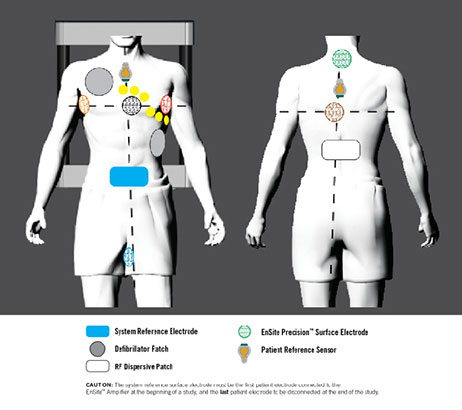
Catheter location and navigation of all compatible tools, both conventional and Sensor Enabled, are based on the impedance field generated by the EnSite surface electrodes. When the surface electrodes are connected to the EnSite Precision Cardiac Mapping System, an 8 kHz signal is sent alternately through each pair of surface electrodes to create a voltage gradient along each axis, forming a transthoracic electrical field.
Conventional or Sensor Enabled electrophysiology catheters are connected to the EnSite Precision Cardiac Mapping System and advanced to the heart. As a catheter enters the transthoracic field, each catheter electrode senses voltage, timed to the creation of the gradient along each axis (Figure 2).
Using the sensed voltages compared to the voltage gradient on all three axes, the EnSite Precision Cardiac Mapping System calculates the three-dimensional position of each catheter electrode for all electrodes simultaneously.
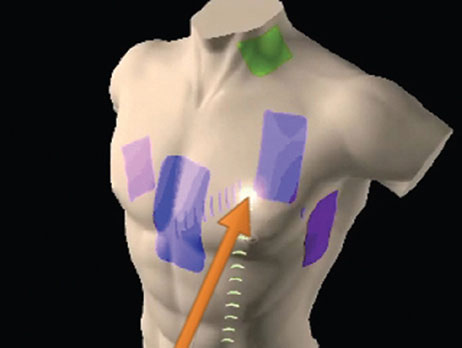
The EnSite Precision Cardiac Mapping System displays the located electrodes as catheter bodies with real-time navigation. It permits the simultaneous display of multiple catheter electrodes (Figure 3) and also reflects real-time motion of ablation and diagnostic catheters in the heart.3 By tracking the position of the catheters, the system enables the creation of 3-D electroanatomical models of the cardiac chambers.
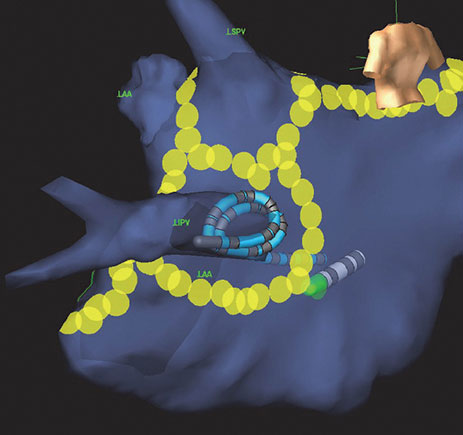
When a Sensor Enabled catheter is introduced and EnSite™ NavX™ Navigation and Visualization Technology, Sensor Enabled Field Scaling is applied, the EnSite Precision Cardiac Mapping System dynamically optimizes the model by adjusting the dimensions of the navigation field using known offsets between the position and orientation of magnetic sensor(s) and electrodes.
The EnSite Precision Cardiac Mapping System also uses magnetic information as an input for the EnGuide stability monitor to monitor field stability for unexpected changes. This feature can be enabled and used to monitor the location of a Sensor Enabled tool real time within an EnSite NavX Navigation and Visualization Technology, Sensor Enabled field scaled mode.
With the EnSite Precision Cardiac Mapping System, you can decrease mapping time using intelligent automation tools.1*
The EnSite Precision Cardiac Mapping System helps you customize your procedure to address the circumstance of each case.
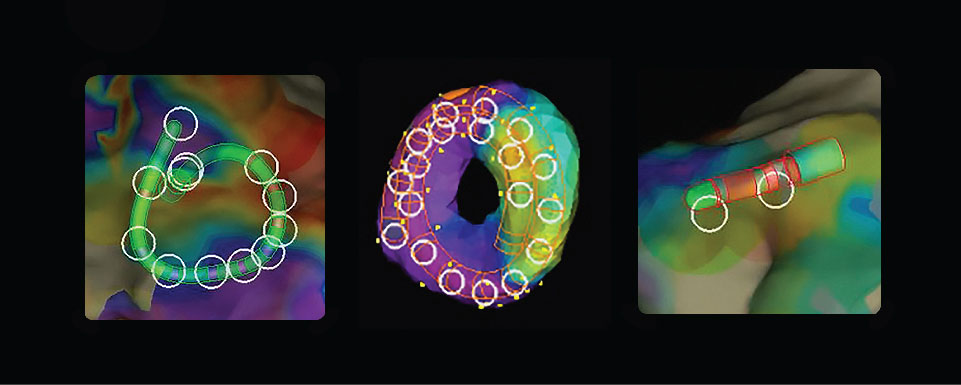
The EnSite Precision Cardiac Mapping System combines impedance and magnetics with a suite of innovative tools to give you comprehensive patient information.
With EnSite Precision Cardiac Mapping System, you can:
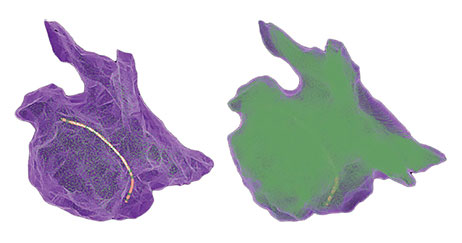
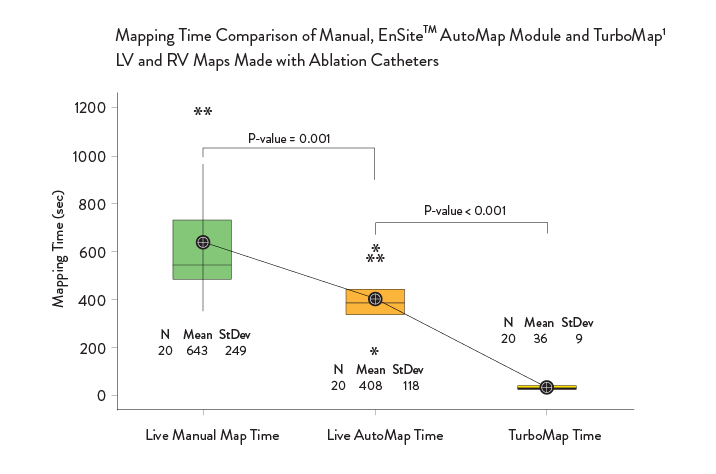
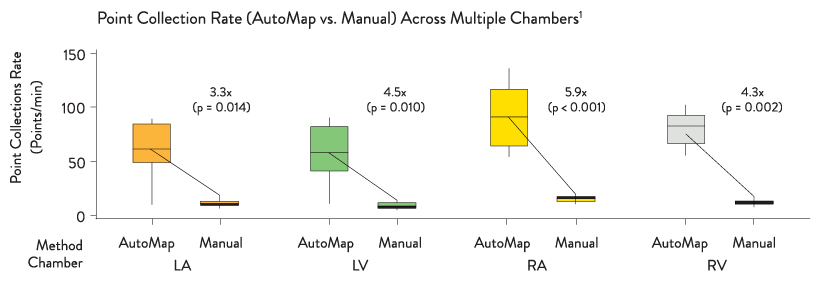
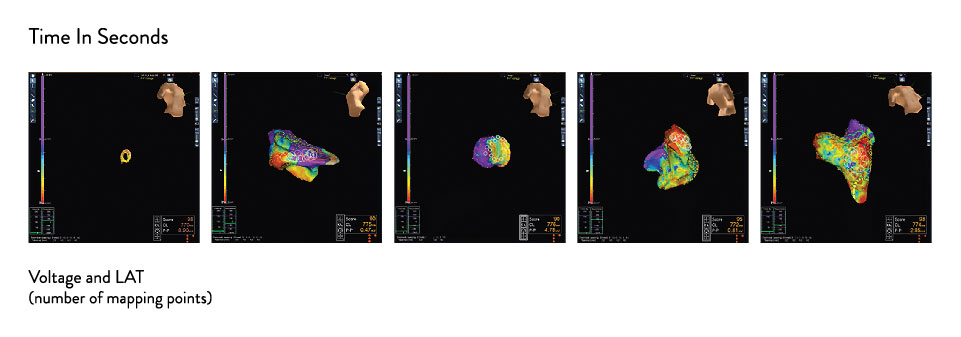
The OneMap and OneModel tools in the EnSite Precision Cardiac Mapping System can be used alongside the EnSite™ AutoMap Module for enhanced mapping capability. The EnSite Precision Cardiac Mapping System with the EnSite AutoMap Module lets you:
* Comparison is versus manual mapping with EnSite Precision mapping module or manual lesion marking.
** The open-platform feature of the EnSite Precision™ cardiac mapping system allows for use of almost any catheter for mapping, thus offering superior flexibility as compared to the CARTO‡ system by Biosense Webster, which limits use to Biosense Webster catheters only.
*** In accordance with catheter indication for use.
**** Greater precision based on improvement in accuracy of impedance model with magnetic field scaling applied via robot testing vs. EnSite Velocity™ v4.0.2.
MAT-2008483 v1.0
STAY CONNECTED